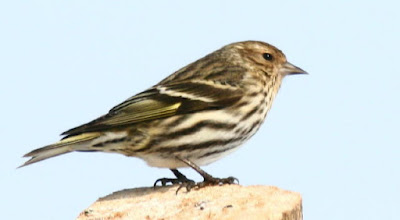Siskins -- © Dave Spier
Pine Siskins (Spinus pinus) are heavily streaked with yellow feather edges on the wings and yellow patches on the inner tail sides. The amount of yellow varies with less on young birds and more on adult males. Since this gregarious bird tends to travel in flocks, at least some members will show varying amounts of yellow. There are also two buffy wing bars. Siskins also hang with goldfinches; both are members of the same family and about the same size and once shared the same genus (Carduelis). Female House Finches are similar, but larger with lower-contrast streaking. Siskins also resemble redpolls, another finch, but redpolls have a red cap. Siskins have notched tail ends, but so do female Purple Finches which have high-contrast streaking, a plumper build and heavier bills. If you’re having trouble, the best bet is to take a photo and send it to northeastnaturalist@yahoo.com
When winter food supplies are short in their Canadian boreal homeland, siskins wander south, showing up first in similar forested habitats in the Adirondacks where significant flocks have been reported throughout October and November. (Details can be found on the Google group, Northern New York Birds. There's also a link in the right sidebar.) Recent reports [Nov. 29] have come from Joan Collins at Sabattis Bog, Little Tupper Lake, several locations on Rt. 28N including flocks totalling 200 in Minerva, and the Roosevelt Truck Trail with 150 siskins. Joan's more recent posts [Dec. 4] from Horseshoe Lake and Low's Ridge-Upper Dam Trail have reported smaller numbers in these locations.
Pine Siskins are one of several kinds of birds referred to as “irruptive species,” meaning they can show up unexpectedly anywhere in the lower 48, and the pattern changes from year to year. A few birds may linger into the spring and act as though they will nest locally, which they do in New York State. The heaviest concentration of nesting records occurs in three clumps from roughly Norwich to Saranac Lake and Lake Placid.
Siskins are seed eaters. They prefer conifers [spruce, pine, cedar and hemlock], but also eat seeds from deciduous trees [especially birch], shrubs [particularly alder], flowers [weeds] and grasses. They readily come to thistle-seed feeders, sometimes in large flocks, but also eat sunflower seeds – basically the same diet as goldfinches. By the way, goldfinches and siskins can feed upside down. Special feeders are made with the seed holes below the perches. In the case of siskins the skill is useful in extracting seeds from conifer cones.
Questions, comments and corrections are welcomed. Some of my other nature columns [more relevant to the Adirondack perimeter and New York lowlands] can be found on http://northeastnaturalist.blogspot.com

No comments:
Post a Comment